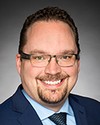Mr. Speaker, it is a pleasure to rise to talk about legislation that all members of the House should get onside with and support.
Bill C-23 is all about people, places, our history and our heritage. When I think about our heritage, a flood of things come to mind about our Canadian identity. It was not that long ago that we were talking about the $198-billion, 10-year health agreement between the national government and all the different provinces. I remember saying that our health care system was at the very core of what it meant to be a Canadian.
We can talk about a policy of that nature or about Canada's rich diversity, which is second to no other country in the world. In fact, I often have had the opportunity to talk about that diversity when I have gone to a multitude of different types of events whether in Winnipeg North or outside it.
We often hear that one of Canada's greatest assets is our diversity. Our heritage is changing everyday through people and the things we do as a society. Compare our values today to what they would have been 30 years ago with respect to diversity and the way in which we approach a wide variety of different areas.
When we a look at Bill C-23, one cannot help but reflect on a private member's bill that was passed through the House a couple of years back. It went through second and third reading. It ultimately went to the Senate, but unfortunately it died in the Senate. It was a private member's bill, Bill C-374, which was introduced by my friend and colleague, the member for Cloverdale—Langley City, a man who is very passionate about our heritage and our parks. I believe that legislation received unanimous support in the House of Commons prior to going to the Senate. That legislation was not word for word to this legislation. In fact, there is a significant difference between what we have before us today and ultimately what passed through the House unanimously but died in the Senate.
The principle of the importance of our historic places, people and acts is something we have to ensure we preserve. Bill C-23 is all about that. That is why I hope that at the end of the day all members will support it.
I did not know about the number of canals in Canada. Why is that important? There are nine historic canals listed in the bill, such as the Rideau Canal, Trent-Severn Waterway, the Sault Ste. Marie Canal. The canal that really made me reflect upon is in the province of Quebec, the Saint-Ours Canal. My ancestry, a few generations back, came from that area. I suspect that some of my family might have even historically been a part of that. The bill goes on to list the canals, whether in Ontario, Quebec or Nova Scotia, and the important role they play. It gives specific directions.
I use the canals as an example because if we look at what the legislation would do, it would establish a very strong framework to deal with something that should be important to all of us.
The designation of a place, person or event in Canada is something we should all take an active interest in. That is what I like about the legislation. I believe passing this legislation will put us at par with and maybe even better than some other jurisdictions. As the member for Cloverdale—Langley City pointed out to members a couple of years back, it is warranted and necessary, and I am glad the department has made it a priority to such a degree that we are now debating it after it was introduced the other day. I hope members see fit to support the legislation so it can go to committee and hopefully receive some sort of passage. Let us get it back into the Senate, hopefully before the end of the year, because as I said, while it is not identical to Bill C-374, it sure did receive a great deal of support.
When I think of the legislation, there are certain parts that are worthy for me to reference. The Truth and Reconciliation Commission is something that many members of the House of Commons and I hold very dear. We want to see action on the calls to action. Over the last number of years, we have seen many calls acted on by this government, whether through statutory holidays or the language legislation. Many different calls to action have been acted on, and within this legislation we are seeing call to action number 79.
It is gratifying, but at the end of the day, it is hard to believe we need to put this into legislation. I think this should have been automatic many, many years ago, and perhaps decades ago. This legislation would ultimately put into place a guarantee of indigenous representation on the Historic Sites and Monuments Board of Canada, for example. This is a board that helps portray Canada's history and where we have come from. How can one not incorporate call to action number 79? I am glad to see it has been incorporated into the legislation. I am also glad to see it note that when a board is looking at some form of designation, it would need to take into consideration indigenous knowledge so we ensure there is a fairer reflection of our history.
I want to give a tangible example that I think has made a profoundly positive difference in the city of Winnipeg. In the city of Winnipeg, we have what we call The Forks, where the Red River and the Assiniboine River come together. There are some historic buildings there. There is the Via Rail station, which is such a wonderful heritage building where often someone can get their citizenship court ceremony. There is also what used to be freight type buildings. At one time, The Forks was a rail yard and there was very limited access to the Red and Assiniboine rivers.
What we had was different levels of government recognizing the heritage within The Forks and investing millions of dollars to convert The Forks into what it is today. They took heritage buildings and converted them to have a modern use while preserving their heritage. We can take a look at the walkways along both the Red River and the Assiniboine River and the value they have added to the city of Winnipeg. Today, it is the most visited spot in the province of Manitoba. I heard a while back there are close to two million visits a year at The Forks, and there is a very important educational component to it for children and adults alike as it continues to evolve.
Prior to this investment and recognition, we might have had virtually no people going down to The Forks. Compared that to what it is today, and ultimately there is no comparison. There is no comparison because at one point in time it was hidden away from the residents of Winnipeg and those who were visiting our city, whereas today it is recognized as one of our shining attractions. If anyone is going to Winnipeg, they have to check out The Forks. It is an area that Winnipeggers are very proud of.
We can talk about downtown Winnipeg, or we can go into rural communities, where there is Riding Mountain National Park. If we were to check with some of my Conservative colleagues from the rural northern area, we would find they are very proud of Riding Mountain National Park, the many things it has to offer and the museums located in many different communities.
What is important, I believe, is that within the legislation, there are mechanisms that would enable anyone to ultimately make a suggestion about and bring forward what they believe should be recognized. It is therefore not just top-down. It is something that allows anyone in our communities to suggest any individual, an example for me being Louis Riel from Manitoba; place, like The Forks, as I highlighted as an example; or event. One could talk about the occurrence that took place in Upper Fort Garry many years ago or what was taking place in Lower Fort Garry, all of which are examples in Manitoba of things that could be recommended in hopes they are accepted.
I talked about the fact that this legislation would put into place a very strong framework, and through it and complemented by regulations, we would see criteria. There is no doubt that we all have personal opinions on what we think should be recognized from a national historical perspective; we all have our personal thoughts on that. However, we need to establish criteria.
First and foremost, I would say that within the legislation, anyone could come up with their thoughts on a person, place or event, and recommend or suggest that it be recognized. The criteria and eligibility would likely restrict a number of those thoughts and ideas, at least possibly in the short term, but at the end of the day, we have an excellent organization in the Historic Sites and Monuments Board of Canada.
With respect to issues of transparency and sustainability and the issue of reconciliation, we have a board in place to protect the interests of Canadians in preserving the important things that we hold dear as part of our Canadian identity. As I mentioned, the legislation would mandate full participation from indigenous community members, along with provinces, which have been there in the past, and a few others. At the end of the day, this is the group of individuals who would ultimately provide recommendations and assist in drawing conclusions.
One thing I did not make reference to is heritage buildings. We have beautiful heritage buildings across our country, and I made reference to a couple of them in my example of The Forks. I am promoting The Forks today, as members can tell. There are federal buildings throughout the country that have played some historical significance.
I think of Pier 21 in Halifax. I remember having a tour of that facility. We get a sense of pride from it, as it is a part of our Canadian identity. Immigration today is so critically important to our country, as it has been in our past, and Pier 21 amplifies that.
Let us look at what has been done to the building. Obviously, if we had a picture that is hundreds of years old, it would look quite different from what it looks like today. However, because of intergovernmental investments and many volunteers who recognized the true intrinsic value of Pier 21, when walking through it today, we see a modernized facility that preserves and protects the heritage of the building itself. That is something we should be encouraging.
Not only does this protect our history and preserve it for future generations, but it also creates jobs. Through alternative uses, it brings people into the facility so they can learn more about our heritage. It becomes an attraction. If we talk to the Minister of Tourism, no matter where he is in Canada, he is talking about how wonderful our tourism opportunities are. We underestimate just how important our heritage can be in promoting tourism. It is used as a magnet for tourism.
If people look at the legislation, they will see it is not controversial. It is legislation that should be universally supported by all members, as we saw when the member for Cloverdale—Langley City brought in Bill C-374 a couple of years back and received unanimous consent. I hope my colleagues in the Conservative Party will recognize that and not want to filibuster this particular bill. Hopefully we will even see it get royal assent before the end of the year. How nice that would be.







